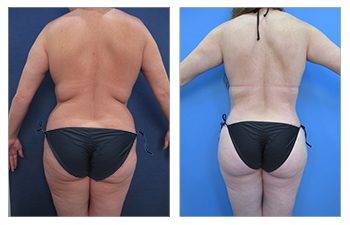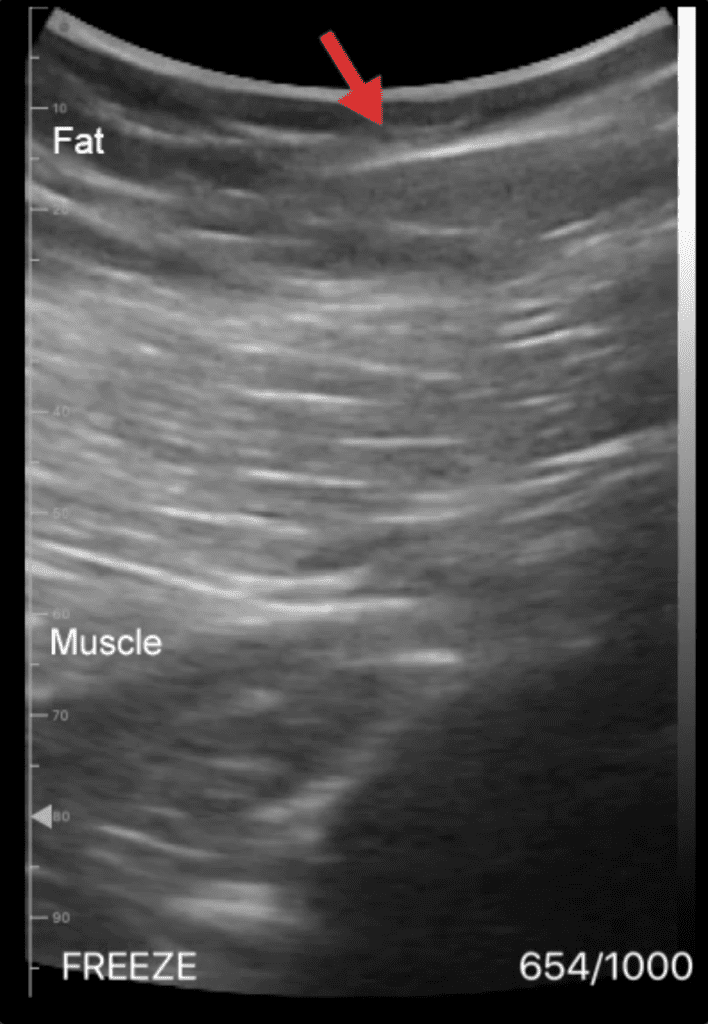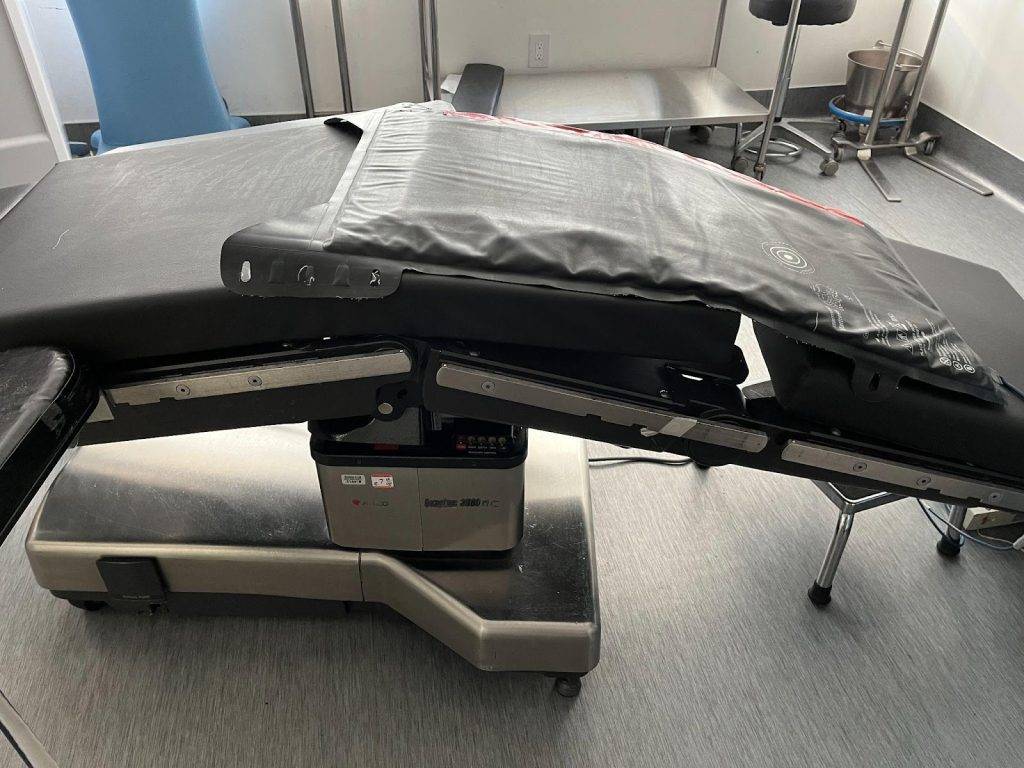


43 year old female who had a safe Brazilian buttock lift with Safe BBL Protocol.
Introduction: Safe BBL Protocol
Safe BBL surgery requires the implementation of several actions to minimize the risk of fat emboli. The premise for taking precautions is to reduce the risk of inadvertent transplant of fat into or below the largest buttock muscle, the gluteus muscle. This is because fat emboli have been identified to occur following the entry of fat into the superior gluteal veins which lie deep in the pelvis beneath the muscle. To appreciate how we can avoid the placement of fat near this vessel, we must consider how fat would get here when we recognize that surgeons are universally aware that fat grafting in this region could be potentially detrimental. At this juncture, several recommendations seem reasonable given observations and reevaluation of fat emboli cases.
To Graft Fat Only in the Subcutaneous Layers
All attempts should be made to limit the transfer of fat to the subcutaneous layer fatty layer. This means void of any intramuscular or submuscular injection of fat altogether! In fact, all of the advised maneuvers listed below are intended to accomplish this goal.
Awareness of Cannula Tip and Buttock Anatomy
Awareness of the cannula tip is a critical step to ensuring that fat is not inadvertently placed into or under the gluteus maximus muscle. Awareness of the cannula tip can be encouraged by two cannula qualifications First, is to make sure that the cannula is stiff and rigid so that it does not bend and to make sure that it is palpable. The second measure is to have a cannula that is generous in caliber, at least 4mm in caliber. This will similarly make it more rigid and palpable.
The anatomy of the gluteal region is critical to ensure that the cannula tip is kept away from the superior gluteal vein vicinity. Several anatomic landmarks have been described and include:
The Bermuda Triangle
It describes a triangular region described by lines drawn from the venous dimple which describes the dimple created from cutaneous ligaments extending down to the posterior superior iliac spine, the greater trochanter, and the coccyx.

Mendietta Guideline
This describes a region just medial to a line drawn from the lateral aspect of the PSIS dimple to the lateral aspect of the ischial tuberosity and located vertically ½ way between the sacral dimple and the coccyx.

Controlled, Limited Injection Technique
To minimize the potential for the development of emboli, a technique for grafting fat in the buttock region has followed principles followed in filler injection in the face. These principles include injecting filler in small aliquots and only in a retrograde fashion. In the face, these principles have proven to minimize the risk of filler emboli into the angular artery and subsequently, the ophthalmic artery that can lead to blindness. In the Buttock region, it is hoped that these principles will minimize the risk of fat emboli.
Use Ultrasound Technology
The use of ultrasound technology has been advocated as a means to guide fat grafting in time. Using cannulas that have been designed to be opaque when viewed under ultrasound guidance, it is feasible to observe the location of the cannula and less so the fat being grafted. There are some limitations to the helpfulness of this modality however and they arise from the fact that you cannot be keeping an eye on the ultrasound monitor and your subject, the buttock cheek, at the same time. This limitation means that you should be using ultrasound guidance to get a lay of the land and only in the areas near the theoretical location of the superior gluteal vein.


Keeping Your Cannula Level
Keeping your cannula level is the final safe BBL guideline and it attempts to keep the fat grafting cannula high and away from the deep buttock region where the superior gluteal vein is located. To achieve this goal several measures may be followed. The first is to keep your hand where you are grabbing the cannula down. When using the infra-gluteal port, it can be challenging to keep your hand down if you have drapes or a bear hugger in the way. Another consideration is to use a non-bulky cannula and one that does not have the hose attached to its butt.

Both of these cannula designs help you avoid inadvertent directing of the cannula tip downward. If you are using an infra-gluteal port, it is prudent to make your port site more lateral so that you steer away from the surgical drapes. A final maneuver to help you stay clear of the deeper buttock zone is to place the bed in a gentle anti-flex position of 10 degrees.

Avoid Strain and or Surgeon Exhaustion
A final presumed cause of fat emboli resulting from inadvertent placement of fat graft material into gluteal muscle may arise from strain and or surgeon exhaustion. Following evaluation of several fat emboli cases, it has been determined that the incidence of fat emboli was increased towards the end of the day, i.e. the latter cases of a surgeon. This observation has led the Florida Medical Board to concede that potential surgeon fatigue may be a cause of inadvertent intramuscular fat injection.
As such, the Florida medical board has advocated a Safe BBL limit of 3 per surgeon per day to try to subvert surgeon exhaustion. Although the actual number may not be so critical, it is prudent to consider that muscle fatigue may lead to inadvertent digression of cannula tip direction to a deeper buttock region. Similarly, it has been observed that fat grafting on the contralateral side of the buttock is more challenging than the ipsilateral side especially when using the infra-gluteal approach. This observation has led some surgeons to advocate limiting fat grafting port site to the sacral zone. Using this approach, entry into the deeper danger zone may be prohibitive.
Limit Brazilian Buttock Lift Volumes
A recent explanation regarding fat emboli occurrence in the superior gluteal vein has involved the concept of fat being siphoned into a torn vein rather than the practitioner directly injecting the vein. This theory follows the presumption that injection of fat into the buttock cheek results in swelling and then tethering of the vein that lives under the gluteus maximus muscle. The submuscular plane under the gluteus maximum mimics that of the subpectoral pocket, which has been described as loose and prone to stretching. Once it is stretched, then a hypothetical tethering and a rip of the superior gluteal vein could occur. What follows is Bernoullil’s theory which describes the negative or sucking pressure created by the vein which has blood moving through it and subsequent differential velocity.
This principle has been presumed to be responsible for the active sucking of any fat particles placed in the area into the vein. As such, it might be concluded that higher fat volumes may result in increased swelling, more likelihood of the superior gluteal vein tearing, and thus an inadvertent fat particle in the vicinity of the vein to be prone to embolization. Even though the volume of fat transferred has not been identified as a risk factor, one should consider that this might intuitively be a risk factor. If not just for the risks of fat necrosis, such as a blowout, or even unnecessary pressure created on the skin, it might be reasonable to limit total fat volumes transferred to less than 1500cc per buttock cheek!
Safe BBL Surgery Conclusion
In summary, Safe BBL surgery may be critical to implement since there has been a temporal increase in fat emboli cases during BBL cases in Miami. As a result, the Florida Medical Board has now taken two actions against BBL surgeons. The first included making a fat injection into the gluteus muscle a criminal act. The second, which was passed in June of 2022, called for emergency action that limited surgeons to no more than 3 BBL surgeries per day and that all BBLs be performed with ultrasound technology.
